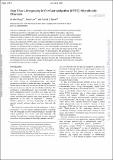Stop flow lithography in perfluoropolyether (PFPE) microfluidic channels
Author(s)
Doyle, Patrick S; Bong, Ki Wan; Lee, Jiseok
DownloadDoyle_Stop flow.pdf (809.2Kb)
OPEN_ACCESS_POLICY
Open Access Policy
Creative Commons Attribution-Noncommercial-Share Alike
Terms of use
Metadata
Show full item recordAbstract
Stop Flow Lithography (SFL) is a microfluidic-based particle synthesis method for creating anisotropic multifunctional particles with applications that range from MEMS to biomedical engineering. Polydimethylsiloxane (PDMS) has been typically used to construct SFL devices as the material enables rapid prototyping of channels with complex geometries, optical transparency, and oxygen permeability. However, PDMS is not compatible with most organic solvents which limit the current range of materials that can be synthesized with SFL. Here, we demonstrate that a fluorinated elastomer, called perfluoropolyether (PFPE), can be an alternative oxygen permeable elastomer for SFL microfluidic flow channels. We fabricate PFPE microfluidic devices with soft lithography and synthesize anisotropic multifunctional particles in the devices via the SFL process – this is the first demonstration of SFL with oxygen lubrication layers in a non-PDMS channel. We benchmark the SFL performance of the PFPE devices by comparing them to PDMS devices. We synthesized particles in both PFPE and PDMS devices under the same SFL conditions and found the difference of particle dimensions was less than a micron. PFPE devices can greatly expand the range of precursor materials that can be processed in SFL because the fluorinated devices are chemically resistant to most organic solvents, an inaccessible class of reagents in PDMS-based devices due to swelling.
Date issued
2014-10Department
Massachusetts Institute of Technology. Department of Chemical EngineeringJournal
Lab on a Chip
Publisher
Royal Society of Chemistry
Citation
Bong, Ki Wan, Jiseok Lee, and Patrick S. Doyle. “Stop Flow Lithography in Perfluoropolyether (PFPE) Microfluidic Channels.” Lab on a Chip 14.24 (2014): 4680–4687.
Version: Author's final manuscript
ISSN
1473-0197
1473-0189